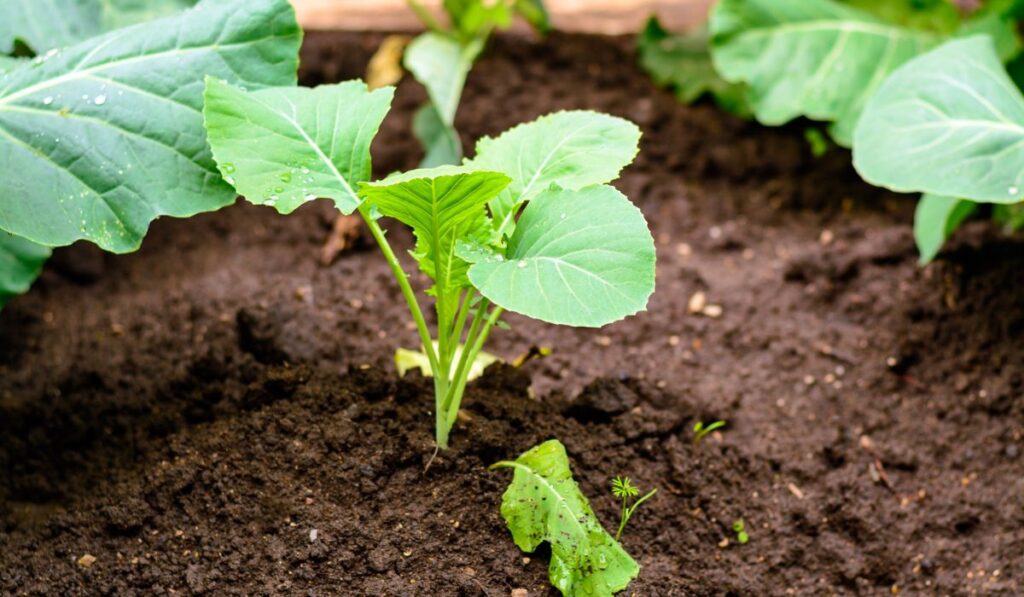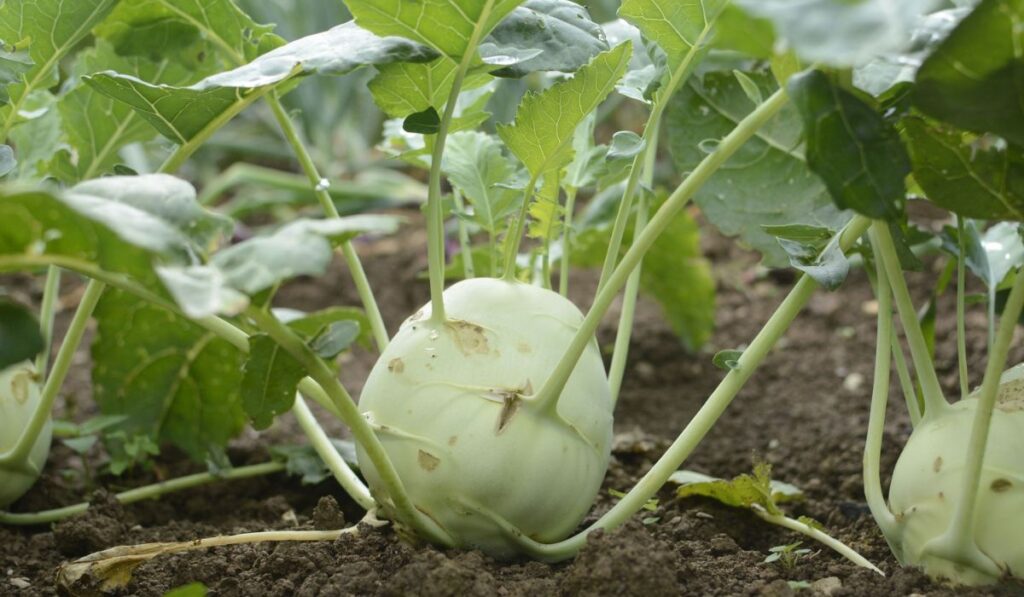Kohlrabi is a cool-season vegetable known for its cabbage- and turnip-like appearance. This colorful crop (usually purple or green) is rich in nutrients and enjoyed for its crispy, fresh, and sweet taste. It’s also a quick-sprouting vegetable that you can eat within weeks of cultivating.
For a kohlrabi seed to germinate and thrive, you should plant it during its peak seasons, which are spring and fall. If planting conditions are ideal (favorable climate, soil, sun exposure, and seed type), you can usually consume the vegetable in less than three months after planting.
Are you looking to plant kohlrabi in your garden? Let’s take a look at all you need to know about cultivating the plant and how to grow it. We’ll also highlight important details like what you can plant next to kohlrabi and the fertilizers to use. Let’s get started!
When Should You Plant Kohlrabi?

Kohlrabi is a cousin of cabbage, and they both belong to the Brassica oleracea family of plants. Kohlrabi thrives primarily during spring and fall, so if you want an early summer harvest, you should sow your kohlrabi in spring.
This plant is a fast-growing crop that takes around 90 days from the seed-planting day to the time of harvest. In addition, it takes approximately 50 to 70 days from the day you sow or pick the vegetable it until it fully ripens.
For the kohlrabi seeds (on Amazon) to grow in about eight weeks, sow over the first four to six weeks following the frost’s final date. However, if you want kohlrabi during the fall and winter seasons, you should re-sow after mid-July to early August.
Don’t plant kohlrabi between mid-May and mid-July when it’s especially hot. The scorching heat will make it produce weak bulbs.
During the short seasons, store kohlrabi indoors in cell trays about a month before the last frost date. Once the day temperatures are consistently above 10 degrees celsius (50 degrees Fahrenheit), you can plant them outside.
The ideal soil temperature for germination is 10-30°C (50-86˚F). And you can expect the seeds to begin sprouting in only 7–10 days.
Kohlrabi Planting Guide: All You Need to Know
Now that we’ve covered the basic facts, it’s time to get your hands dirty.
Remember not to plant kohlrabi in areas where other Brassica family members were grown within the last two or three years. This will minimize the spread of diseases and retain the soil’s richness.
Before sowing, ensure you rake out lumps, weeds, and stones. Then, you can dig a ½-inch deep hole.
Here’s a quick Kohlrabi planting guide:
- Plant kohlrabi a month before the last frost for a spring yield.
- Spread kohlrabi at least 9 to 12 inches away from each other in a location with enough sun and nutritious soil that has a pH of 6.5 to 6.8.
- Add fertilizer and rich organic material to the soil to improve it.
- Because kohlrabi grow quickly, offer them 1 to 1.5 inches of water per week to keep the soil moistened.
- Feed plants consistently with plant nutrients that are soluble in water to promote exceptional leaf formation.
- To prevent weeds while keeping the soil moist, apply a significant layer of mulch composed of organic material, such as finely powdered bark or leaves.
- You’ll know it’s time to harvest this plant when leaves are between 2.5 to 4 inches wide.
Does Kohlrabi Need Full Sun?
Yes. For kohlrabi to flourish, it requires at least 6 hours of total sun exposure. This way, it will become more succulent and develop a sweet and juicy flavor.
What Can You Plant Next to Kohlrabi?
You can plant kohlrabi near deciduous plants that haven’t yet leafed out. Alternatively, you can plant it with the following:
- Ammi: This companion plant will lure parasitic wasps, ladybird beetles, and lacewings and serve as an effective pest control plant in your kohlrabi garden.
- Alyssum: Alyssum is excellent for attracting pollinators and serves as a barrier to weed growth between rows of plants. Spiders and ground beetles also find refuge in alyssum.
- Agastache: Bees are drawn to Agastache plants. They are excellent for discouraging cabbage moths from devouring Brassica crops. Only plant a row far from the garden and avoid planting near radishes.
- Broad beans: They are suitable for enriching the soil in your garden with nitrogen.
- Borage: Borage repels cabbage moths and tomato hornworm caterpillars. It’s also particularly alluring to pollinators, not to mention a great addition to compost and soil.
- Beets: Beet greens are excellent for composting because they release iron and manganese into the soil. As compost for beets, you can add chopped mint leaves, but don’t grow them close to pole beans.
- Chamomile, dill, mint, rosemary, and sage are helpful to all brassicas. But ensure you don’t plant them beside potatoes or eggplant because they demand moderately acidic soil with a pH range of 5.5 to 6.5. On the other hand, kohlrabi prefers more neutral ground with a pH range of 6.5 to 7.0.
- Celery: Your kohlrabi will go perfectly well with celery.
- Chervil: They are great partners for radishes, lettuce, and Brassicas. Chervil prevents slugs while attracting parasitic wasps.
How Much Space Does Kohlrabi Need?
Vertically, kohlrabi doesn’t shoot that high. It does, however, require horizontal space. Therefore, you should place each plant at least 2.5 cm apart. You can also offer your plants a lot more space than that — if you have it!
The seeds should be sown a half-inch deep while thin viable seedlings can be placed between 12 to 20 cm apart. Separate rows by 45 to 60 cm. Afterward, spread thinned seedlings to other areas of the garden. For intensive spacing, plant seeds or transplants in a double row 10 to 15 cm apart.
How to Grow Kohlrabi
Plant Kohlrabi around a month before the final frost so that they can mature during springtime. If they are straight from the greenhouse, they will require immediate shelter from the cold.
You can also plant your kohlrabi around six weeks before the first frost. Note that plants that have been gradually toughened by being exposed to cool temperatures are usually resistant to frost in the fall.
Kohlrabi needs no less than six hours of direct sunlight daily although more hours are advisable. Till it under rich organic soil (moist, well-drained, and fertile). To prevent it from acquiring clubroot diseases, sow the seeds in soil with a pH of around 6.5 and 6.8.
You can determine the soil’s pH using a pH meter (on Amazon) or request a soil examination from your nearest CSREES (Cooperative Extension Service). Then, lime and fertilize as per the test requirements.
You should also add components full of nitrogen like cottonseed meal (on Amazon) or soymeal to nourish it, enrich the soil, and prevent both over-and under-watering (without using a soil test).
Kohlrabi must receive a consistent flow of water to develop nutritious bulbs. To keep the soil moist and discourage the growth of weeds, you should also add compost, crushed leaves, or chopped bark.
If it doesn’t rain, use a rain gauge to pour 1 to 1.5 inches of water each week.
How Long Does It Take to Grow Kohlrabi?

Kohlrabi typically needs 70 to 90 days to mature from seed to harvest. This depends on several variables, including the climate zone in which you grow your kohlrabi, the soil, the specific type of kohlrabi seed, how much sun your kohlrabi plants receive, and your level of expertise.
If you’re a beginner, it’ll likely take your kohlrabi much longer to grow than if you were a gardening expert.
What Fertilizer Does Kohlrabi Need?
If you’re looking for the best kohlrabi fertilizers, here’s a quick guide:
Miracle-Gro All Purpose Plant Food
Miracle-Gro All Purpose Plant Food (on Amazon) is one of the best fertilizers for kohlrabi, and it’s not hard to see why. It feeds instantly, leading to a healthy, fleshy crop. You should apply it after every two weeks through a garden feeder.
What makes this fertilizer stand out is its 24-8-16 blend. It contains healthy minerals like calcium and organic materials, essential for proper growth, strength, and increased yield in kohlrabi. It usually lasts for up to three months.
Osmocote Flower and Vegetable Plant Food
If you want to improve kohlrabi’s vigorous growth and root development, Osmocote Flower and Vegetable Plant Food (on Amazon) is your remedy. It’s one of the easiest fertilizers to use, and it lasts up to 4 months.
It was explicitly manufactured for kohlrabi with its 15-9-12 soil mixture. As such, it ranks among the best organic kohlrabi fertilizers.
Miracle-Gro Shake and Feed
Miracle-Gro Shake and Feed (on Amazon) is among the best garden fertilizers for increased yield and healthy growth. It contains calcium and natural materials to keep your kohlrabi strong. The fact that you can use it both above ground and in pots makes it exceptional.
Old Farmer’s Almanac Vegetable Fertilizer
The makers of Old farmer’s Almanac Vegetable Fertilizer (on Amazon) had kohlrabi and organic plants in mind during its manufacturing. You can use it in a 250-square-foot area. In addition, it stays for about two months and has both immediate and gradual release to support long-term healthy all-around vegetable growth.
Dr. Earth’s Vegetable Fertilizer
Dr. Earth’s Vegetable Fertilizer (on Amazon) contains seven various microbes, probiotics, and no GMOs. Moreover, it includes the perfect amount of nutrients to produce delicious kohlrabi.
Can Kohlrabi Survive Frost?
Yes. Kohlrabi can withstand a frost, even with temperatures in the mid-20s. It would, however, be best to plant kohlrabi to mature a week or two before the typical first frost date.
